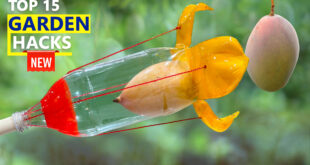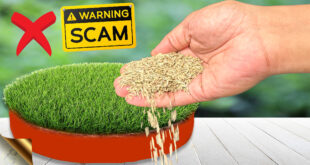In Today’s post, we will quickly tell you 10 organic secrets to Increase Flowering in Hibiscus tree whether you are growing in pots or in ground. These tips are really easy to follow and you can maintain blooms in your hibiscus plant throughout the year.
Before we start, I always start with the word “Organic Gardening” which uses natural and organic sources of fertilizers and pesticides. Please avoid the use of chemical fertilizers and pesticides to protect our mother earth from the hazards of chemicals. Now, Let’s list out the 10 organic secrets and tips to boost flowering in Hibiscus bush.
10. REPOTTING: Most of us think repotting is the first and foremost task as soon as you bring your plant home from a nursery or a garden store. No! This is not true. Do not repot immediately. Allow your plant to settle down for at least one week to its new place and then consider repotting. During repotting, you need to mix some important ingredients into the potting mix like for a 12-inch pot, roughly about 1 tablespoon of steamed bone meal powder which is a great source of phosphorous. Phosphorous strengthens the root system and a strong root system is indispensable for flowering and plant growth. The vegan alternative to bone meal is Organic rock phosphate. Optionally you can also mix the Mycorrhizae fungi – the beneficial fungi or even pseudomonas and Trichoderma powder. You can check my detailed posts on these topics from HERE.
9. CONTAINER SIZE: A simple concept to remember while choosing your pot size is: if you choose a deeper container, the plant will start focussing more on root development due to increased soil space and less on flower production. Though this may be useful in the long run. But to get faster results and boost flowering, the best one is a container that is wider than the usual nursery pot, but still not too deep. Like for instance, if your plant came in a 6-inch container, go for a 8 inch container. If you choose this method, you might need to repot it every year in a graded manner like increasing 2 inches every time you repot.
8. LOCATION: Keep your plants away from the traffic and pollution. Dust accumulating on the leaves can impair photosynthesis – that’s plant food production, which in turn reduces plant growth and flowering. It can also reduce the flower size. So, you might want to remember this tip to get big sized flowers. The solution to this problem if you have no option to shift the plant to a better location is – misting the plant with water and cleaning the leaves with a soft cloth. Or if you have lots of plants, then using your watering hose in shower mode and gently pressure wash your plants while watering.
7. SUNLIGHT: Place your plant in a location where you get adequate direct sunlight. Hibisucs needs at least 6 hours to 8 hours DIRECT SUNLIGHT for proper flowering. Without direct sun, you cannot expect hibiscus to flower. If it’s too hot like in summer season or to protect it from noon sunlight which can sometimes cause leaf burning and drying, you can install a 50% green shade net in summer season.
6. WATERING: If you are growing in containers, daily watering is must specially in summer season. Here you don’t need to check using moisture meter or finger dip method. Just daily watering and deep watering. If it’s winter season, it may need less frequent watering depending on the zone you live in. One most important thing to check is the drainage hole of your container. Check for its patency. Make sure water flows out of it after you thoroughly water your plant. Water stagnation can result in root rot and death of your plant. Do not worry about over watering if you have a patent drainage hole and also if you are using a well-draining soil mix. We will discuss about the potting mix shortly.
5. PEST CONTROL: Controlling pests is very important step to keep the plant healthy and blooming. Examine the plant closely for pests and insects including underside of the leaves. Common pests like whiteflies, aphids, mealybugs can be easily eliminated using organic neem oil + liquid soap spray weekly once. Depending on the ppm concentration of your neem oil brand, you add 5 to 10 ml of neem oil per litre of water and few drops of liquid soap. Shake well and spray this once every week to treat pests and once every 15 days as a preventive measure.
4. RAKING OR TILLING THE SOIL: This is just loosening your top soil using a raking or tilling tool. This is an important step everyone must follow before applying any fertilizer or manure to your plant. Raking or tilling the soil is recommended once every 15 days, which improves soil aeration and has many benefits. Make it a habit to rake the soil and then apply your fertilizer every 15 days.
3. POTTING SOIL: Here you should remember few important factors like:
a) Soil PH b) Thing to mix in Potting soil to get more flowers c) Keeping the soil well-draining. The First factor is PH. Hibiscus prefers a slightly acidic soil like around 6.0 +/-0.5. If you have a PH testing meter, you can alter the soil ph to acidic by using Alum powder hack. Even if you do not have this meter and your plant is not performing well, you can roughly add about 5 gms of alum powder in one litre of water once every 15 days to maintain this acidic level, which is very important for absorption of nutrients in the soil. The other alternative to Alum is to use 1 – 2 teaspoon of white vinegar per litre of water weekly once to make your soil acidic.
Now the potting mix recipe. To get adequate flowering, you can follow a simple formula: 30% Garden Soil, 30% Compost like cow dung or vermicompost and 30% Cocopeat or Peat moss. 10 percent additional stuff like bone meal powder, neem cake powder, mycorrhizae, Trichoderma, etc as discussed earlier.
2. FERTILIZER: In this video, I will be talking only about organic fertilizers and not chemicals like NPK or DAP.
You add a handful of decomposed cowdung or horsedung or even goat dung or vermicompost on the top layer of the soil once every 15 days after nicely raking or tilling the top soil. This should be the minimum fertilizer use and frequency to get big sized flowers as well as increase flowering. If you want to get still better results, You can also use compost tea sprays or even mustard cake tea sprays or watering and other foliar feeds once in a while like once in month. You can also prepare a Cocktail Fertilizer Powder containing most of the useful organic fertilizers available. You can check a detailed post on how to prepare this mixed fertilizer powder.
1. PRUNING: Yes this is another important step which many of us neglect. Some newbie gardeners actually hesitate to trim the plants. But this should not be the case. Pruning or trimming the plant branches encourages the formation of more branches and hence more flowering. You can soft prune or trim the plant all round the year. And you can do hard pruning once in a year. You can check detailed post Pruning Tutorial – on when to prune and how to prune and what pruning tools you need. You also need to perform deadheading of the flowers from time to time. Dead heading means removing the dead and dried flower along with its twig or branch and this is another important step for maintaining blooms as this will divert the energy to plant growth and more flowering rather than seed formation.
 GKVKs – Gardening Tips and Store Gardening Tips and Store
GKVKs – Gardening Tips and Store Gardening Tips and Store



